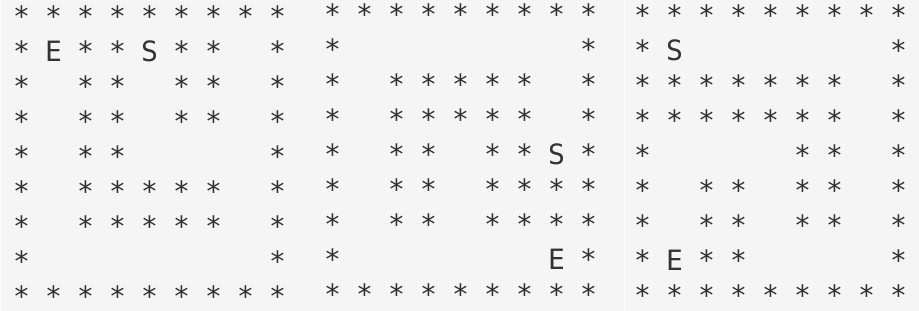Works In Progress: Generating a Maze in Python

Last year I was messing around with maze generation. I thought I was going to make another game (more on that later). I didn’t get very far, but I did learn how to use the recursive backtracking algorithm to create a 2D maze. I was thinking about that algorithm again during Advent of Code, as many of the problems turn out to be maze/traversal problems, and, well, I’ve been meaning to write this up anyway. It’s not really a complete project, but I found it interesting, and maybe you will as well?
There are a lot of maze algorithms out there. The recursive backtracking one is one of the easiest, I’m told.
The general gist: Start with a grid of possible spaces. Choose one to start, and “knock down” the wall between it and a random neighbor. Choose another direction at random, and if it has not yet been visited, knock down the wall there. Once all locations at a given square have been visited, backtrack; once the algorithm reaches the starting point the maze is complete.
Implementing it in Python looks like this:
DX={"N":0,"S":0,"E":1,"W":-1}
DY={"N":-1,"S":1,"E":0,"W":0}
class Maze():
def __init__(self, size, seed="default"):
#init the maze
self.size = size
self.game_map=np.zeros(shape=(self.size,self.size),dtype=object)
for y,row in enumerate(self.game_map):
for x, square in enumerate(row):
self.game_map[y][x] = Room(x, y) #this is not strictly necessary, I wanted my maze Room class to have some other features that I will discuss later
start_x = random.randint(0,self.size-1)
start_y = random.randint(0,self.size-1)
self.make_the_maze(start_x,start_y)
def make_the_maze(x,y):
current_room=self.get_room(x,y) #returns an instance of the Room class with these xy coordinates
current_room.visited=True
directions = ["N","S","E","W"]
random.shuffle(directions)
for direction in directions:
new_x = x+DX[direction]
new_y = y+DY[direction]
if (0<=new_y and new_y<self.size) and (0<=new_x and new_x<self.size) and not self.get_room(new_x,new_y).visited:
#recurse
self.make_the_maze(new_x,new_y)
maze = Maze(3)
This allows us to declare a square maze of length and width n and create a maze where all squares are visited at least once and with one entry and exit. This implementation doesn’t really do anything, though – ideally we would be, oh, counting the number of valid, unique paths from point A to point B, for example. Or rendering it on a screen.

What I wanted to do with this maze, though, is turn it into a text adventure. By saving each room’s doors (e.g. doors: {'N':True,'S':False} etc…) I can use that to generate an Inky file:
#still in the Maze class
def render_text(self, start_x, start_y):
with open("game.ink","w+") as inkfile:
inkfile.write("You are about to enter the spooky maze!\n")
inkfile.write(f"+[Go in] -> room_{start_x}_{start_y}\n")
for room in self.get_all_rooms():
self.write_room(inkfile, room)
def write_room(self, inkfile, room):
x = room.x
y = room.y
inkfile.write(f"===room_{x}_{y}===\n")
if room.is_finish:
inkfile.write("You have found the exit and/or the amazing treasure!->END")
else:
inkfile.write("You are standing in a maze of twisty passages, all alike.\n")
doors = room.get_doors()
exits = [direction for direction in doors if doors[direction]]
if len(exits)>1:
inkfile.write(f"There are exits to the {','.join(exits)}\n")
else:
inkfile.write(f"There is an exit to the {exits[0]}.\n")
for door in exits:
new_x = x+DX[door]
new_y = y+DY[door]
inkfile.write(f"+[Go {door}] -> room_{new_x}_{new_y}\n")
An .ink file is used by the Inky editor to create narrative adventures. The Inky editor uses a Markdown-ish syntax to create choose-your-own-adventure style games.
I had this idea that I could make a procedurally-generated choose-your-own-adventure (with more interesting narration than the “maze of twisty passages” stuff, of course) and then, using the same seed, create a visual representation of the same maze, that two players would solve together. The Room class would be essential for this and would contain things like: does this room contain a locked door, or a key, or a monster, or a landmark? I haven’t gotten around to implementing it yet but you get the general idea.
So, it’s pretty bare-bones and doesn’t do anything yet, but to my knowledge (and upheld by a very quick Google–please reach out if I missed you) this is one of the earliest examples of procedurally generated Inky games. I hope to have some time to get back to this eventually, but *waves hands* life has been getting in the way. For now, I’m happy to have had a chance to learn a maze algo.
Resources
I am indebted to Jamis Buck’s ‘Buckblog’ post on maze generation; his writeup in Ruby was the only thing that helped me make sense of doing the same in Python. It should be noted that he has an entire book about mazes that I am probably going to be buying shortly.